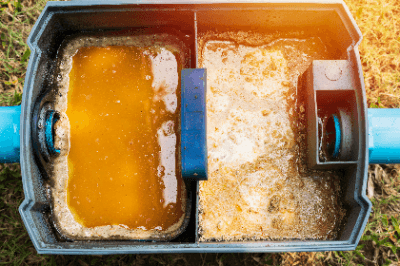What Is an Oil Trap?

Oil Traps are devices used to capture oil, fat, and other liquids in machinery and equipment.
It is mainly used in the industrial field to prevent oil and fat generated during machine operation from leaking outside. These devices are known by various names, such as Oil Trap, Gasoline Trap, Oil/Water Separation Tank, Oil Separation Basin, Oil/Water Separation Catch Basin, Grease Trap, etc.
In addition to preventing oil from leaking into wastewater, one of the purposes of installation is to prevent clogging of sewage pipes and public gutters. They are generally made of metal or plastic and equipped with an internal filter and separator. They can also be maintained and cleaned regularly to keep them functioning effectively.
Uses of Oil Traps
Oil Traps are one of the most widely used devices in industry.
Lubricants for machine parts and mechanisms can leak out during machine operation. In facilities that handle petroleum or chemicals, leaks can have serious consequences. Oil Traps can be used to capture lubricants and petroleum and prevent them from leaking outside.
In addition, wastewater from industrial processes and restaurants may contain oil and fat. Removing oil and fat from wastewater can reduce the treatment load at wastewater treatment facilities.
During automobile maintenance, fluids such as engine oil and transmission oil can also leak out. Oil Traps can be used to reduce the impact on the environment around the vehicle.
Oil Trap Principle
The most common type of Oil Trap is the one that separates water and oil by the difference in specific gravity.
Oil Traps have an inlet where liquid flows in and an outlet where fresh water is discharged. Inside the Oil Trap are baffles (barriers) that slow the flow of liquid. The baffles allow light oil and fat in the liquid to float to the top, while heavy sewage settles at the bottom.
At the top of the Oil Trap is an oil skimmer to remove oil. The oil skimmer removes oil and fat from the surface and collects them in a separate container. Meanwhile, a valve is installed at the bottom of the Oil Trap to drain the sewage. By opening the valve, sewage can be drained out.
Types of Oil Traps
There are various types of oil traps. The main types are float type, bio type, and those designed for mineral oil.
Float type oil traps are equipped with a buoyant body inside. When a light liquid such as oil or fat floats to the top, the buoyant body opens a valve inside the Oil Trap to discharge the oil. The discharged oil can be collected in a separate container.
A bio-based Oil Trap is a device used to break down oil and fat in wastewater by microorganisms. Inside the trap, a medium for microorganisms to grow and an air blower are installed. Wastewater decomposed by microorganisms is treated in a subsequent purification system.
Oil Trap for mineral oil is a device used to prevent lubricating oil leakage from machine parts and mechanisms. It is characterized by its special filters and separators to trap oil. Oil Traps provide high oil separation performance.
How to Select an Oil Trap
When selecting an Oil Trap, the type of oil, separation performance, and ease of maintenance should be taken into consideration.
Oil Trap selection equipment differs depending on the type of oil. If the oil trap is to be used to prevent lubricating oil leakage from machine parts or mechanisms, an oil trap for mineral oil should be selected. On the other hand, if the oil trap is to be used to separate oil and fat contained in wastewater discharged from restaurants, factories, etc., a bio-oil trap should be selected.
The separation performance of Oil Trap depends on the type and design of the filter or separator used. When selecting one, it is necessary to select one that has high separation performance and minimal environmental impact.
Installation space and maintainability are also important factors. Since filter cleaning must be performed on a daily basis, products that can be easily cleaned and filters replaced are preferred. Large equipment can provide large flow rates, but filter cleaning may be complicated and require dedicated space.